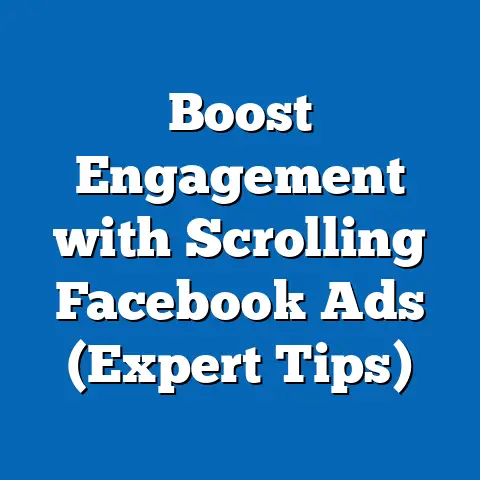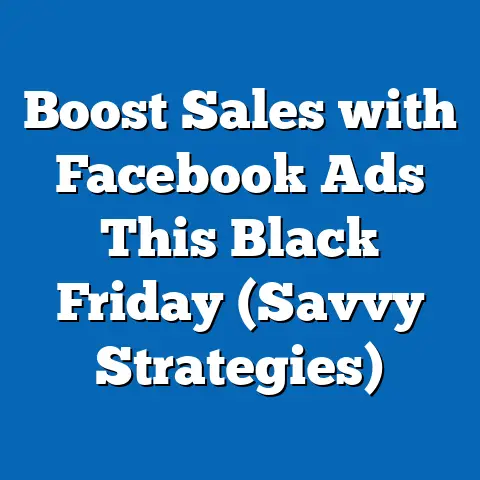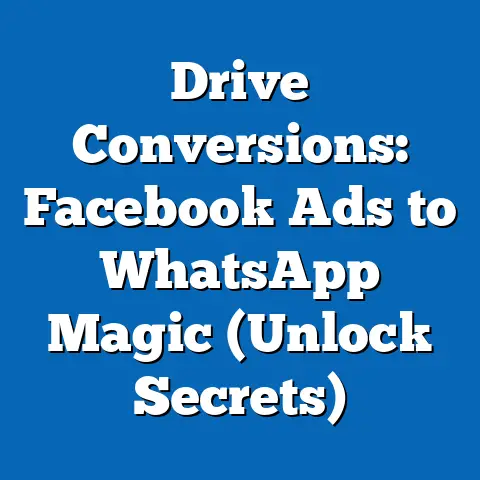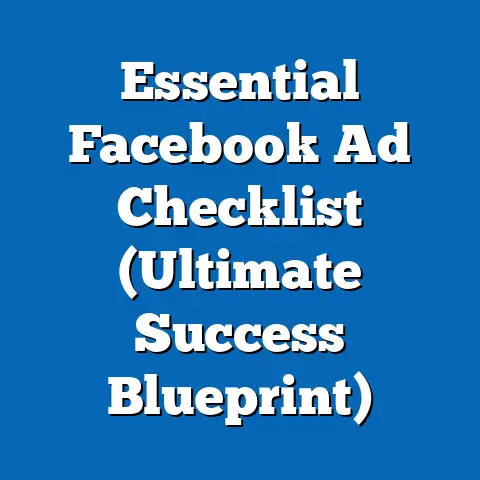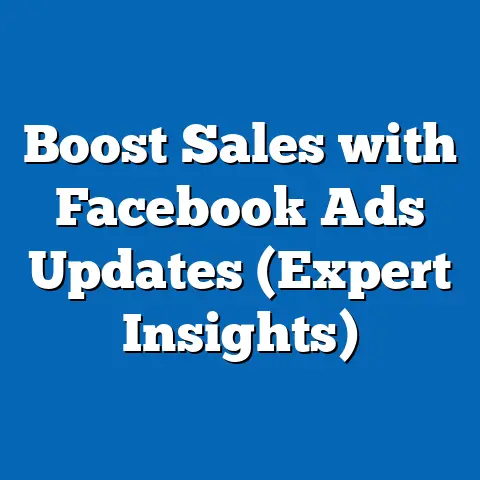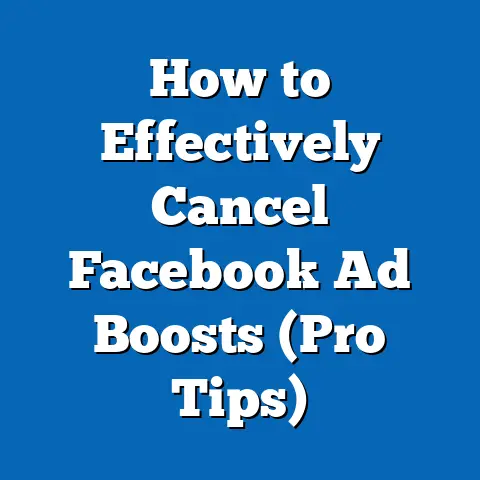Maximize Ad Impact by Timing Facebook Ads (Expert Insights)
Understanding Facebook’s Algorithm and User Behavior
The foundation of any successful Facebook advertising strategy lies in understanding the platform’s inner workings. The Facebook ad algorithm is a complex beast, constantly evolving and learning. At its core, it aims to deliver the most relevant and engaging content to each user, maximizing their time spent on the platform. This means that your ad’s visibility isn’t just about your budget; it’s about how well your ad resonates with the target audience and aligns with Facebook’s goals.
Think of it like this: Facebook wants to keep its users happy and scrolling. If your ad is perceived as intrusive, irrelevant, or low-quality, the algorithm will penalize it by reducing its reach and increasing its cost. Conversely, if your ad is engaging, informative, and well-targeted, the algorithm will reward it by showing it to more people and potentially lowering your cost per result.
But understanding the algorithm is only half the battle. We also need to understand user behavior. People use Facebook differently throughout the day and week. Some might check it religiously during their morning commute, while others might only browse in the evenings after work. Knowing these patterns is crucial for timing your ads effectively.
For instance, studies have shown that Facebook usage tends to peak during weekdays between 11 AM and 1 PM, coinciding with lunch breaks. Another peak occurs in the evenings, from 8 PM to 10 PM, when people are winding down for the day. On weekends, usage is generally more consistent throughout the day. However, these are just broad trends. Your specific audience might have entirely different habits.
Key Takeaway: Understanding the Facebook algorithm and general user behavior is crucial. Ads are more effective when they align with user activity patterns.
The Science of Timing in Advertising
Timing in advertising isn’t just about showing your ad when people are online; it’s about showing it when they’re most receptive to your message. This delves into the realm of psychology and consumer behavior. There’s a “right moment” to deliver an ad, a point where the consumer is most ready to engage or even make a purchase.
Consider the concept of “purchase intent.” Someone browsing Facebook at 10 AM on a Monday morning is likely in a different mindset than someone browsing at 8 PM on a Friday night. The Monday morning user might be checking for news updates or connecting with colleagues, while the Friday night user might be looking for entertainment or inspiration for the weekend.
Therefore, the ads you show them should reflect their respective mindsets. A B2B software ad might be more effective on a weekday morning, while an ad for a local restaurant or event might perform better on a Friday or Saturday evening.
Marketing experts often talk about “ad recall” and “consumer sentiment.” Timing can significantly impact both. An ad shown at an inopportune moment might be easily forgotten or even create a negative impression. However, an ad that’s timely, relevant, and well-placed can leave a lasting positive impression and increase the likelihood of recall.
I remember working on a campaign for a local coffee shop. We initially ran ads throughout the day, but the results were underwhelming. After analyzing the data, we realized that most of their customers visited the shop in the morning for their daily caffeine fix. So, we shifted our focus to running ads primarily between 6 AM and 10 AM, targeting people within a specific radius of the shop. The results were remarkable. We saw a significant increase in website traffic, in-store visits, and ultimately, sales.
Key Takeaway: Timing in advertising is about understanding the psychological and behavioral aspects that influence consumer readiness to engage or purchase.
Analyzing Your Audience’s Online Activity
While general trends can provide a starting point, the real magic happens when you analyze your specific audience’s online activity. Facebook Insights and Analytics are your best friends here. These tools provide a wealth of data about your followers and website visitors, including their demographics, interests, and online behavior.
Here’s a step-by-step approach to analyzing your audience’s peak activity times:
-
Access Facebook Insights: Navigate to your Facebook Page and click on the “Insights” tab.
-
Explore the “Posts” Section: In the left-hand menu, click on “Posts.” This section provides valuable data about when your audience is most active on Facebook.
-
Analyze “When Your Fans Are Online”: Pay close attention to the graph that shows “When Your Fans Are Online.” This graph displays the average times and days when your followers are most active on Facebook.
-
Segment Your Audience: If you have different audience segments, consider creating separate custom audiences in Facebook Ads Manager and analyzing their activity patterns individually.
-
Use Google Analytics: If you’re driving traffic to your website from Facebook, use Google Analytics to track the times and days when users are most likely to visit your site. This can provide additional insights into their online behavior.
Access Facebook Insights: Navigate to your Facebook Page and click on the “Insights” tab.
Explore the “Posts” Section: In the left-hand menu, click on “Posts.” This section provides valuable data about when your audience is most active on Facebook.
Analyze “When Your Fans Are Online”: Pay close attention to the graph that shows “When Your Fans Are Online.” This graph displays the average times and days when your followers are most active on Facebook.
Segment Your Audience: If you have different audience segments, consider creating separate custom audiences in Facebook Ads Manager and analyzing their activity patterns individually.
Use Google Analytics: If you’re driving traffic to your website from Facebook, use Google Analytics to track the times and days when users are most likely to visit your site. This can provide additional insights into their online behavior.
Once you’ve gathered this data, you can use it to tailor your ad scheduling. For example, if you discover that your audience is most active on Facebook between 7 PM and 9 PM on weekdays, you can schedule your ads to run during those times.
Remember, segmenting your audience is key. Different demographics and interests might have different online habits. Tailoring your ad timing based on these differences can significantly improve your results.
Key Takeaway: Use Facebook Insights and Google Analytics to gather data on your specific audience’s online habits and tailor your ad scheduling accordingly.
Case Studies and Real-World Examples
Let’s dive into some real-world examples to illustrate the power of strategic ad timing.
Case Study 1: E-commerce Fashion Brand
An e-commerce fashion brand selling trendy clothing targeted young adults aged 18-25. Initially, they ran ads throughout the day, but their conversion rates were low. After analyzing their Facebook Insights data, they discovered that their target audience was most active on Facebook in the evenings, particularly between 8 PM and 11 PM.
They adjusted their ad scheduling to focus on these peak times and also tailored their ad creative to reflect the evening mindset. They featured images of people going out and having fun, and their ad copy emphasized the brand’s trendy and stylish clothing. As a result, they saw a 40% increase in conversion rates and a significant improvement in their return on ad spend (ROAS).
Case Study 2: Local Restaurant
A local restaurant wanted to attract more customers during lunchtime. They initially ran ads throughout the day, but they weren’t seeing the desired results. They decided to experiment with ad timing. They ran ads specifically between 11 AM and 1 PM, targeting people within a specific radius of the restaurant.
Their ad copy emphasized their delicious lunch specials and quick service. They also included a call to action to “Order Online Now.” As a result, they saw a 25% increase in lunchtime orders and a significant boost in their overall revenue.
Case Study 3: B2B Software Company
A B2B software company wanted to generate more leads for their sales team. They initially ran ads throughout the day, but their lead quality was inconsistent. They decided to focus on targeting business professionals during work hours.
They ran ads between 9 AM and 5 PM on weekdays, targeting people with specific job titles and industries. Their ad copy emphasized the benefits of their software for improving productivity and efficiency. They also included a call to action to “Request a Demo.” As a result, they saw a 30% increase in lead quality and a significant improvement in their sales conversion rates.
These case studies highlight how different industries may have varying peak times and how adaptability is key to success. What works for one business might not work for another. It’s essential to analyze your own data and experiment with different timing strategies to find what works best for your specific target audience.
Key Takeaway: Real-world examples show that strategic ad timing can significantly improve results. Different industries and target audiences may have varying peak times.
Expert Tips for Timing Your Facebook Ads
Now, let’s compile a list of actionable tips from marketing experts and successful advertisers on how to effectively time your Facebook ads:
-
Start with General Trends: Begin by leveraging general trends in Facebook usage. Target peak times for your overall audience based on available data.
-
Analyze Your Audience Data: Dive deep into Facebook Insights and Google Analytics to understand your specific audience’s online habits.
-
Segment Your Audience: Create separate custom audiences and tailor your ad timing based on their individual activity patterns.
-
Experiment with Different Time Frames: Don’t be afraid to experiment with different time frames. Test running ads at various hours of the day and days of the week to see what works best.
-
Utilize A/B Testing: Use A/B testing to compare the performance of ads run at different times. Create two identical ads and schedule them to run at different times. Monitor the results and adjust your strategy accordingly.
-
Monitor Performance Metrics: Continuously monitor your ad performance metrics, such as click-through rate (CTR), conversion rate, and cost per result. Adjust your ad timing based on the data you collect.
-
Consider Time Zones: If you’re targeting a global audience, be mindful of time zones. Schedule your ads to run during peak times in each time zone.
-
Align with Specific Events: Consider aligning your ad timing with specific events or promotions. For example, if you’re running a weekend sale, schedule your ads to run primarily on Friday and Saturday.
-
Be Flexible and Responsive: Stay informed on evolving trends and audience shifts. Be prepared to adjust your ad timing as needed.
-
Don’t Set It and Forget It: Ad scheduling is not a “set it and forget it” task. Regularly review your data and make adjustments to optimize your results.
Start with General Trends: Begin by leveraging general trends in Facebook usage. Target peak times for your overall audience based on available data.
Analyze Your Audience Data: Dive deep into Facebook Insights and Google Analytics to understand your specific audience’s online habits.
Segment Your Audience: Create separate custom audiences and tailor your ad timing based on their individual activity patterns.
Experiment with Different Time Frames: Don’t be afraid to experiment with different time frames. Test running ads at various hours of the day and days of the week to see what works best.
Utilize A/B Testing: Use A/B testing to compare the performance of ads run at different times. Create two identical ads and schedule them to run at different times. Monitor the results and adjust your strategy accordingly.
Monitor Performance Metrics: Continuously monitor your ad performance metrics, such as click-through rate (CTR), conversion rate, and cost per result. Adjust your ad timing based on the data you collect.
Consider Time Zones: If you’re targeting a global audience, be mindful of time zones. Schedule your ads to run during peak times in each time zone.
Align with Specific Events: Consider aligning your ad timing with specific events or promotions. For example, if you’re running a weekend sale, schedule your ads to run primarily on Friday and Saturday.
Be Flexible and Responsive: Stay informed on evolving trends and audience shifts. Be prepared to adjust your ad timing as needed.
Don’t Set It and Forget It: Ad scheduling is not a “set it and forget it” task. Regularly review your data and make adjustments to optimize your results.
I’ve found that one of the most effective strategies is to start with a broad approach, running ads at various times and days, and then gradually refine my timing based on the data I collect. It’s an iterative process that requires constant monitoring and adjustment.
Key Takeaway: Actionable tips from experts include analyzing data, segmenting audiences, A/B testing, and continuously monitoring performance metrics.
Conclusion
In conclusion, ad timing is a critical element in maximizing value for money in Facebook advertising. By understanding the Facebook algorithm, analyzing your audience’s online activity, and implementing strategic timing strategies, you can significantly enhance engagement, improve conversion rates, and achieve a better return on investment.
Remember, timing is not a one-size-fits-all solution. What works for one business might not work for another. It’s essential to analyze your own data, experiment with different approaches, and continuously monitor your results.
By implementing the strategies discussed in this article, you can unlock the full potential of Facebook advertising and achieve your business goals. Stay informed on evolving trends and be prepared to adapt your strategies as needed. The world of digital advertising is constantly changing, and those who are willing to learn and adapt will be the ones who succeed.
Now, go forth and conquer the world of Facebook advertising, one perfectly timed ad at a time!
Call to Action
I’d love to hear about your experiences with timing your Facebook ads. Share your insights and strategies in the comments section below. Let’s learn from each other and help each other achieve success in the ever-evolving world of digital advertising. If you have any questions or would like to discuss this topic further, feel free to reach out!

